Project Loses It's Utility Agreement
October 4, 2014 - Riverside County CA - Pacific Gas & Electric canceled the power purchase agreement to the Rice power tower project after Solar Reserve failed to obtain financing for the solar development. It had been approved in December 2010 but delayed. SolarReserve CEO Kevin Smith said Rice was on "indefinite hold." His company has had significant delays constructing the similar Crescent Dunes power tower near Tonopah, Nevada because of engineering problems. The utility agreement could be re-negotiated in the future.
See more at The Desert Sun: http://www.desertsun.com/story/tech/science/energy/2014/10/03/rice-solar-project-blythe/16671507/
Final Environmental Impact Statement Out
August 5, 2011 -
[Federal Register Volume 76, Number 151 (Friday, August 5, 2011)]
[Notices]
[Pages 47608-47609]
From the Federal Register Online via the Government Printing Office
[www.gpo.gov]
[FR Doc No: 2011-19916]
-----------------------------------------------------------------------
DEPARTMENT OF THE INTERIOR
Bureau of Land Management
Notice of Availability of the Final Environmental Impact Statement for the Rice Solar Energy, LLC Rice Solar Energy Project and Proposed California Desert Conservation Area Plan Amendment
AGENCY: Bureau of Land Management, Interior.
ACTION: Notice of Availability.
-----------------------------------------------------------------------
SUMMARY: In accordance with the National Environmental Policy Act of 1969, as amended (NEPA), and the Federal Land Policy and Management Act of 1976, as amended (FLPMA), the Western Area Power Administration (Western), the Bureau of Land Management (BLM), and the California Energy Commission (CEC) prepared a Final Environmental Impact Statement (EIS) and California Desert Conservation Area (CDCA) Plan Amendment for the Rice Solar Energy Project (RSEP) in Riverside County, California. By this Notice, the BLM is announcing the availability of the Proposed CDCA Plan Amendment/Final EIS.
DATES: The BLM planning regulations state that any person who meets the conditions as described in the regulations may protest the BLM's Proposed CDCA Plan Amendment. A person who meets the conditions and files a protest must file the protest by September 6, 2011.
ADDRESSES: Copies of the RSEP Proposed CDCA Plan Amendment/Final EIS have been sent to affected Federal, State, and local government agencies and to other stakeholders. Copies are available for public inspection at the Palm Springs South Coast Field Office, 1201 Bird Center Drive, Palm Springs, California 92262. Interested persons may also review the document at the following Web site: http://www.wapa.gov/transmission/RiceSolar.htm. All protests must be in writing and mailed to one of the following addresses: Regular Mail: BLM Director (210), Attention: Brenda Hudgens- Williams, P.O. Box 71383, Washington, DC 20024-1383. Overnight Mail: BLM Director (210), Attention: Brenda Hudgens- Williams, 20 M Street, SE, Room 2134LM, Washington, DC 20003.
FOR FURTHER INFORMATION CONTACT: Ms. Liana Reilly, NEPA Document Manager, Western Area Power Administration, P.O. Box 281213, Lakewood, Colorado 80228-8213, e-mail: RiceSolar@wapa.gov; or Ms. Allison Shaffer, Realty Specialist, telephone 760-833-7100, address (see above field office address), e-mail CAPSSolarRice@blm.gov. Persons who use a telecommunications device for the deaf (TDD) may call the Federal Information Relay Service (FIRS) at 1-800-877-8339 to contact the above individual during normal business hours. The FIRS is available 24 hours a day, 7 days a week, to leave a message or question with the above individual. You will receive a reply during normal business hours.
SUPPLEMENTARY INFORMATION: The proposed Rice Solar Energy Project (Project) is a 150 megawatt (MW) solar electric power plant that would use concentrating solar "power tower'' technology to capture the sun's heat to make steam, which would power traditional steam turbine generators.
The solar generation facility, located on privately owned land, would contain the power block, a central receiver or tower, a solar field consisting of mirrors or heliostats to reflect the sun's energy to the central tower, a thermal energy storage system, technical and non-technical buildings, a storm water system, a water supply and treatment system, a wastewater system, evaporation ponds, construction parking and laydown areas, and other supporting facilities. The Project would use an air-cooled condenser (i.e., dry cooling technology) for power plant cooling. Water for the project (approximately up to 180 acre-feet per year) would be obtained from two new on-site wells.
Rice Solar Energy, LLC (RSE) has applied to Western to interconnect the proposed Project to Western's transmission system. A new 10-mile-long 230-kV generator tie-line would extend from the southern boundary of the solar facility to a new substation adjacent to Western's existing Parker-Blythe transmission line. The substation would be owned and operated by Western and would be approximately 3 acres in size. RSE has submitted a right-of-way (ROW) application to the BLM for the Project components (the generator tie-line, substation, and access road) to be constructed on a total of about 150 acres of land managed by the BLM. The project site is in an undeveloped area of the Mojave Desert in eastern Riverside County, California, near State Route 62, about 40 miles west of Blythe, California, and 15 miles west of Vidal Junction, California, on lands managed by the BLM.
The BLM's purpose and need for the RSEP is to respond to RSE's application under Title V of FLPMA (43 U.S.C. 1761) for a ROW grant to construct the 161-kV/230-kV transmission line, substation, and access road on public lands in compliance with FLPMA, BLM ROW regulations, and other applicable Federal laws. The BLM will decide whether to approve,
approve with modification, or deny the ROW for the proposed RSEP project. The BLM will also consider amending the CDCA Plan (1980, as amended) in this analysis. The CDCA Plan, while recognizing the potential compatibility of solar generation facilities on public lands, requires that all sites associated with power generation or transmission not identified in that plan be considered through the plan amendment process. If the BLM decides to grant a ROW, the BLM would also amend the CDCA Plan, as required.
The Final EIS evaluates the potential impacts of the proposed RSEP and CDCA Plan Amendment on air quality, biological resources, cultural resources, water resources, geological resources and hazards, land use, noise, paleontological resources, public health, socioeconomics, soils, traffic and transportation, visual resources, wilderness
characteristics, and other resources.
A Notice of Availability for the RSEP Draft CDCA Plan Amendment/Draft EIS was published by the EPA in the Federal Register on October 27, 2010 (75 FR 66078). The formal 90-day comment period ended on January 20, 2011. Comments were considered and incorporated as appropriate into the Proposed CDCA Plan Amendment/Final EIS. Public
comments resulted in the addition of clarifying text, but did not significantly change proposed land use plan decisions. On June 10, 2011, the EPA published a Notice of Availability in the Federal Register for the RSEP (76 FR 34073). That notice, however, did
not identify the BLM's proposed plan amendment or the associated opportunity for protest. Today's notice fulfills the BLM's requirement, found at 43 CFR 1610.5-2, to provide eligible persons such opportunity. Instructions for filing a protest with the BLM Director regarding
the Proposed CDCA Plan Amendment may also be found at 43 CFR 1610.5-2. E-mail and faxed protests will not be accepted as valid protests unless the protesting party also provides the original letter by either regular or overnight mail postmarked by the close of the protest period. Under these conditions, the BLM will consider the e-mail or faxed protest as an advance copy and it will receive full consideration. If you wish to provide the BLM with such advance notification, please direct faxed protests to the attention of the BLM protest coordinator at 202-912-7212, and e-mails to Brenda_hidgens-williams@blm.gov. All protests, including the follow-up letter to e-mails or faxes, must be in writing and mailed to the appropriate address, as set forth in the ADDRESSES section above. Before including your phone number, e-mail address, or other personal identifying information in your protest, you should be aware that your entire protest--including your personal identifying information--may be made publicly available at any time. While you can ask us in your protest to withhold your personal identifying information from public review, we cannot guarantee that we will be able to do so.
Public Hearing: Give Comments
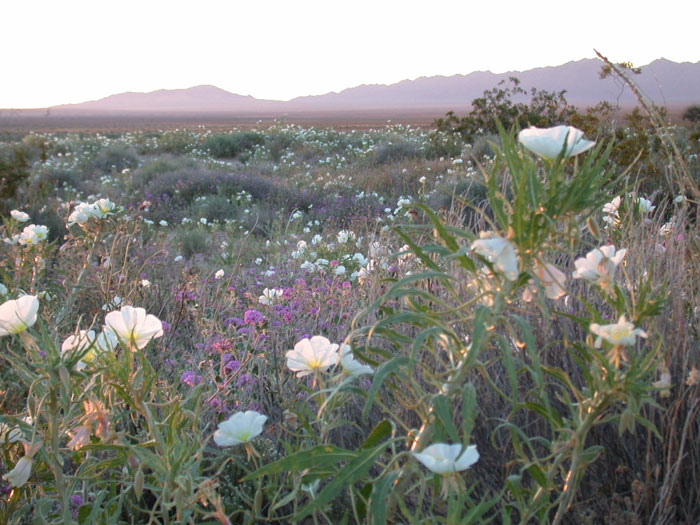
^Rice Valley at sunrise with spring wildflowers: Desert sand verbena (Abronia villosa) and Dune evening primrose (Oenothera deltoides). (Photo by Bob Ellis)
December 21, 2010 - The public is invited to review Western Area Power Administration’s and the Bureau of Land Management’s (BLM) draft environmental findings on the proposed Rice Solar Energy Project.
Date: January 5, 2011
Open House: 5 to 6 pm (PST) Hearing: 6 to 8 pm (PST)
Location: University of California Riverside, 75080 Frank Sinatra Drive Palm Desert, CA 92211.
Western Area Power Administration, BLM, and the California Energy Commission conducted a joint environmental review of the Proposed Project in a single combined NEPA/CEQA process and document. The Notice of Availability published in the Federal Register on October 27, 2010 announced the start of the 90-day public comment period. The DEIS is available for review at public libraries in Parker, AZ, and in Blythe and Desert Center, CA, as well as at Western’s Customer Service Region in Lakewood, CO and at BLM’s Palm Springs-South Coast Field Office in Palm Springs, CA. A copy of the DEIS can also be requested from Western via email at RiceSolar@wapa.gov. You can make comments on the DEIS at the public hearing, submit them via Western’s website, or send them by letter/fax/email to the address below. All comments must be received by January 20, 2011.
Send comments to:
Ms. Liana Reilly, Western Area Power Administration, P.O. Box 281213 Lakewood, CO, 80228-8213 Fax: (720) 962-7263 E-mail: RiceSolar@wapa.gov.
In the View of Six Wilderness Areas
December 17, 2010 - Another great report from Bob Ellis of Desert Survivors:
Among the many events impacting the desert over the past couple days was Wednesday's approval of the Rice Solar Project by the California Energy Commission.
While a relatively small project (150 Megawatts), on private disturbed land, with some energy storage to allow partial off-peak power generation; this generally unopposed project will have a huge and devastating impact on the surrounding public lands.
Why?
Destruction of the Rice Valley Viewscape - This is one of those few remaining California Desert valleys with little or no development. The project will build a mile wide circle of moving mirrors which will focus sunlight up over 500 feet in the air to the top of a 600-foot power tower seeming "like a partial sun". The views from the surrounding mountains and valleys now look across many miles of currently undisturbed landscape. The tower and often the mirror array will be visible from, not two, not four, but SIX surrounding wilderness areas. As the Bureau of Land Management's own visual resource guidelines indicate the placement of an intrusive industrial facility in the landscape of primarily natural visual values; this is a significant impact. It is not coincidence that a number of Desert Survivor trips have focussed on this valley and the surrounding mountains over the years. We have even done a couple of service trips with the BLM to improve areas along the Rice Valley Road. Some Desert Survivor members find this area so inviting that they independently spend many days camping out in this area. Ingrid and I have spent some nights at the Arica Mine, a viewspot to the west, and many nights at the Iron Mountain Camp to the northwest. We have stopped several times in the Spring just south of Rice to photograph flowers in the sandy spots and have pictures of flowers carpeting the area toward the project. Not long ago we were camping north of Rice when hiking in the southern Turtle Mountain wilderness. Last Spring we hiked in the Riverside Mountains wilderness and appreciated the Rice Valley viewscape to the west. Its a peaceful place in spite of occasional traffic along Highway 62.
No environmental group had commented on this project. It is out-of-the-path for most non-hikers and non-backpackers. The other larger projects were taking all the activists' energy. This seemed to be a "best-of-the-bad" project and had gotten no attention from desert protection groups including Desert Survivors. We were notified that not only had no one commented on the project, but that the draft decision proposed for adoption concluded that construction of the project had no significant environmental impact and that routine approval should be granted.
I submitted comments to the California Energy Commission just before their December 3rd committee meeting. I was asked by the Public Advisor to the Energy Commission if I could make some comments via phone to the Board about our group's objections to the project. I spoke for a few minutes outlining our dismay at their finding that the viewscape destruction was not significant. I described our group's use and appreciation of the area.
On December 14th, the afternoon before the final Commission meeting, I was called by the Public Advisor who said that an "Errata" or revision to the proposed decision had been made and the Desert Survivors comments had affected the decision. She emailed me a copy of the long list of mostly technical changes to the project approval document. Under Visual Resources the board had recognized that users like Desert Survivors would find that the tower and mirrors would significantly affect their enjoyment of the area and that this impact could not be mitigated. Therefore the proposed decision now acknowledged the project's significant unmitigatible environmental impact to the visual resources of the area. However, as has been done in all the other projects so far; they now added language overriding the finding of significant environmental impact, due to the nation's greater need for renewable energy and job creation. On December 15th the Rice Project, as amended, was unanimously approved by the California Energy Commission.
We got our objections acknowledged, and have standing as an interested party, but the project is going forward. Its possible that because no tribal consultation occurred, for this as well as other projects, some delays could result. We'll wait and see.
Complete Destruction of Surrounding Area by More Solar Projects - The approval of one solar project invites the approval of other projects. In Ivanpah valley there are now proposals for three additional solar projects next to, or not too far from, the already approved Ivanpah solar project. The rationale for the one nearest the Ivanpah Project includes the argument that the area is already impacted by one project so why not have two. Across the road to the northwest and west of Rice are proposals for more projects. No doubt when evaluated they will say that the view has already been impacted by one project so its not so bad to add just one more nearby.
There is something very wrong with the review process when the first process can't use arguments about probable subsequent projects but the second project can use the first to justify further destruction.
Just today the Federal Government released proposed solar development areas for California and guess what? The Iron Mountains and Rice Valley area are included as potential solar development areas, "available for application". I'm sure the already approved Rice Project will be used as a justification for adding more to the general area. Time to drive Highway 62 before development occurs.
Bob Ellis
Rice Solar Issues
Desert Survivors
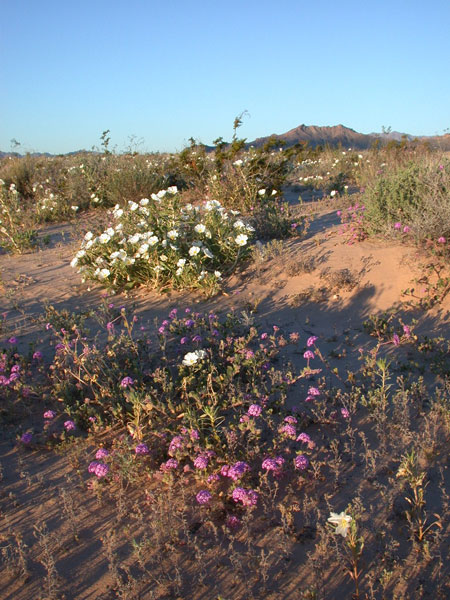
Rice Midland Road, spring wildflowers. (Photo by Bob Ellis)
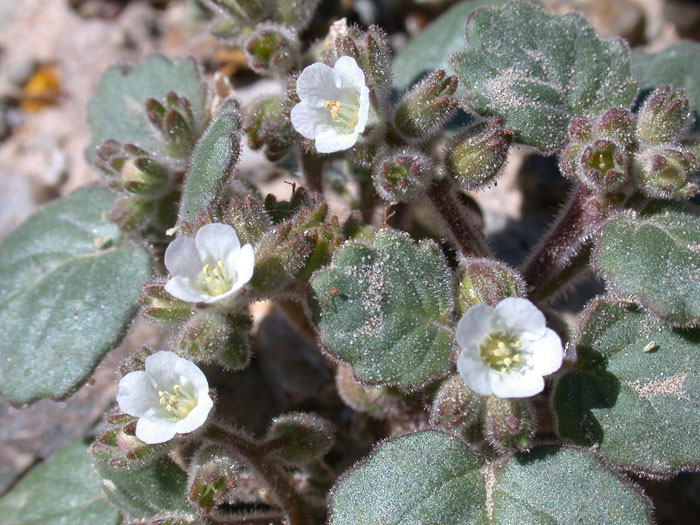
^Round-leaf phacelia (Phacelia rotundifolia) (Photo by Bob Ellis)
Impacts Not Mitigated
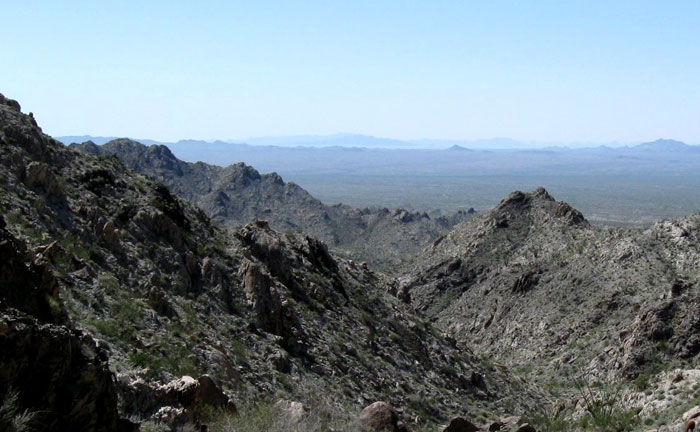
^View of Rice Valley beyond the mountains, Vidal Valley in the middle ground, from the Chemehuevi Range, California.
December 4, 2010 - Our friends at Desert Survivors know this wild part of the Mojave-Colorado Desert transition zone well. It is a remote and beautiful valley surrounded by jagged mountain ranges, not a good place for a power plant so far from cities. See the California Energy Commission page on Rice Solar Energy Project.
Comment letter:
Bob Ellis
Rice Valley Solar Issues
Desert Survivors
Oakland, CA
CALIFORNIA ENERGY COMMISSION
1516 Ninth Street
Sacramento, CA 95814
docket@energy.state.ca.us
RICE SOLAR PROJECT
Docket # 09-AFC-10
Robert B. Weisenmiller, Ph. D
Presiding Committee Member
RE: Comments on the PMPD for Rice Solar Project - SIGNIFICANT IMPACTS NOT MITIGATED
Dear Sir:
Thank you for the opportunity to make comments on the California Energy Commission’s Presiding Members Proposed Decision for the RICE SOLAR PROJECT.
Desert Survivors feels most strongly that the project will cause SIGNIFICANT IMPACTS to which will not be mitigated by this proposal. These impacts are in the areas of VISUAL RESOURCES, CULTURAL RESOURCES, and PUBLIC SAFETY.
Desert Survivors is an environmentally-oriented organization of people interested in the conservation of desert and arid areas in California and Nevada. Our focus is to educate people about desert and arid area protection issues by leading trips, publishing informational materials and working with public land managers and advocates to protect and conserve our rapidly vanishing natural areas.
We have long been involved in California desert protection issues working for passage of the California Desert Protection Act and commenting on numerous management actions in the various BLM resource areas. We have led hikes in the Turtle Mountains Wilderness, the Riverside Mountains Wilderness, the Little Marias and Palen Wilderness. Our members have camped in the Arica Mountains, off the Rice Midland Road and along the Parker-Blythe #2 transmission line road proposed to be linked with the Rice Project. We have visited the abandoned Rice Patton Camp and airport, we have visited the Rice Dunes Wilderness and camped many times at the Iron Mountain Patton Camp. This mostly BLM California Desert landscape is very important to our group. We have walked the ground, we have beheld the views, we have been awed by the vast open spaces of this complex of desert valleys and surrounding mountains. We are an interested party in area management and a staunch defender of its natural values.
Desert Survivors is quite concerned with this proposal. We are astounded that the proposed decision concludes that the project will have NO SIGNIFICANT IMPACTS!
Visual Resources - Your proposed decision says that a 600 foot tower with a 100 foot sun-like brilliant top less than a mile from the well-traveled state highway in a vast mostly natural desert valley with multi-mile sight-lines is NOT a significant impact. You are leaving yourself open to ridicule, if not legal action with this seemingly politically motivated decision. Please at least acknowledge this impact. If you need Secretary Salazar to override the impact, go ahead, but it is surely significant.
A good deal of the enjoyment we as a group have had camping and exploring in this valley is the natural landscape on which this immense shining tower would forcibly intrude. Its visibility from the surrounding wilderness areas which we visit will be especially offensive.
Cultural Resources, Historical - This project is being built directly on top of the Rice Patton Camp and Airport. The Patton Camps are a significant cultural historical resource for the California desert. In the viewscape of this valley are the Granite Mountain and Iron mountain Camps. Destruction of an entire camp is SIGNIFICANT. It is not sufficient mitigation to dig up and store the artifacts. A large part of the historical value of the Patton camps is the lonesome desert landscape that the young soldiers experienced as they prepared for war. You are the first to authorize the obliteration of a Patton Camp and its replacement with an industrial development; it is a significant loss; please acknowledge it.
Cultural Resources, Native American - This area is a center of native American trails, your document acknowledges that. We don’t see any government-to-government consultation documentation with the Chemehuevi Tribe who generally feel that this area is a sacred landscape. Members of our group have participated with Chemehuevi Tribal efforts save sacred sites and trails in the Blythe Solar Project and there are no-doubt similar concerns here at a landscape level.
Public Safety - There are some general aviation aircraft using the Highway 62 corridor or coming north from Blythe and Midland. A new 600 foot tower is definitely a safety hazard not matter how well light. The scale of this structure makes it significant. Again lets acknowledge the facts.
Land Usage - Scenic Highway - This area along Highway 62 has been proposed for Scenic Highway designation. We agree with that assessment and support the designation. It is a favorite desert drive to leave Twenty Nine Palms and drive eastward on Highway 62. Two lane, mostly without powerlines, and always with a landscape view; this is scenic highway defined. A 600 foot shining tower is grotesquely out of place. Big impact from this proposal. Significant.
Biological Resources - You had better expect a greater number of tortoise removals than your survey has uncovered. Recent experience at the Ivanpah Solar has shown that these preliminary surveys are not reliable and under-count the actual tortoises. It may be that the alternate powerline route which will destroy less natural tortoise habitat is a better choice as it uses the existing road.
Powerplant Reliability - This plant is in the path of consistent sand transport corridors. The Rice Valley Dunes are just to the south, and sand flow is coming from the northwest, crossing the northernmost part of the Rice-Midland Road and blowing over the southern project area. Often in the Spring we stop along the road here to look at the sand-loving wild flowers. How long will it take the sand to dull the mirrors and get into the moving mirror towers? Not long. This higher level of maintenance will erode any profitability the project might have. Those of us with pitted windshields well understand this.
Energy Storage - No data is provided with respect to the amount of energy which might be generated from stored heated salt. It is not likely to be very much of the rated capacity or for very long, but we aren’t given any data. Part of the justification of this plant is the feature to create off-peak output, but without any more than generalities, its usefulness can’t be evaluated.
Project Alternatives - Desert Survivors supports the development of solar projects; First, on the rooftops of urban areas where the power is needed. Secondly, on disturbed lands close to urban areas. While this project uses disturbed private land, most of the disturbance is of a valuable historical nature! Its visual impacts directly intrude on a huge natural landscape surrounding the project. This project is better placed closer to the urban area it is designed to serve.
Solar Land Rush - Boom and Bust! - By agreeing to this project in this place and agreeing to destroy much of the scenic landscape value of this area, you are rushing ahead of the normal deliberative land preservation ethic which has been generally been followed since the federal designation of the California Desert Conservation Area in 1976. Already this rush to build on natural landscapes in the desert is easing off. Political winds are shifting, money for subsidies is getting scarce. Lets wait a bit to see if we really need this project. A better long-term conservation tactic is promotion of reduced energy usage.
Preserve for Future Generations - BLM’s mandate is to preserve the land for future generations. Some now argue that the landscape and the natural ecosystem must be sacrificed for those future generations.
“The mission of Desert Survivors is to experience, share and protect the desert, a beautiful, fragile and threatened environment deserving of respect and requiring constant vigilance.”
Our remaining natural landscapes don’t deserve hurry-up ill-thought treatment.
Thanks for your time and attention. Please keep us informed of any new information about these issues. I would be happy to discuss any questions you have regarding these comments.
Sincerely yours,
Bob Ellis
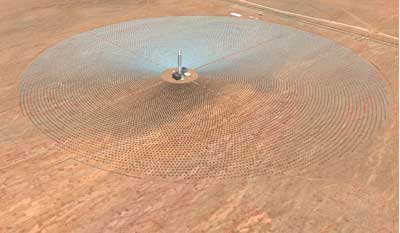
^Digital image of the proposed Rice Solar Energy Project power tower.
